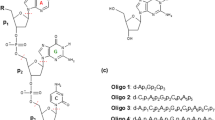Abstract
The molecular forces involved in protein-nucleic acid interaction are electrostatic, stacking and hydrogen-bonding. These interactions have a certain amount of specificity due to the directional nature of such interactions and the spatial contributions of the steric effects of different substituent groups. Quantum chemical calculations on these interactions have been reported which clearly bring out such features.
While the binding energies for electrostatic interactions are an order of magnitude higher, the differences in interaction energies for structures stabilised by hydrogen-bonding and stacking are relatively small. Thus, the molecular interactions alone cannot explain the highly specific nature of binding observed in certain segments of proteins and nucleic acids. It is therefore logical to assume that the sequence dependent three dimensional structures of these molecules help to place the functional groups in the correct geometry for a favourable interaction between the two molecules.
We have carried out 2D-FT nuclear magnetic resonance studies on the oligonucleotide d-GGATCCGGATCC. This oligonucleotide sequence has two binding sites for the restriction enzyme Bam H1. Our studies indicate that the conformation of this DNA fragment is predominantly B-type except near the binding sites where the ribose ring prefers a3E conformation. This interesting finding raises the general question about the presence of specificity in the inherent backbone structures of proteins and nucleic acids as opposed to specific intermolecular interactions which may induce conformational changes to facilitate such binding.
Similar content being viewed by others
References
Arnott, S. (1971)Prog. Biophys. Mol. Biol.,21, 265.
Arnott, S. and Hukins, P. W. L. (1972)Biochem. J.,130, 453.
Aue, P., Bartholdi, E. and Ernst, R. R. (1976)J. Chem. Phys.,64, 2229.
Brown (1970)Biochim. Biophys, Acta.,213, 282.
Bruskov, V. I. (1975)Molek. Biol.,9, 304.
Caillet, J. and Claverie, P. (1975)Acta. Crystalogr.,31A, 448.
Claverie, P. (1978) inIntermodular Interactions; From Diatomics to Biopolymers, (ed. B. Pullman) (New York: Wiley) p. 69.
Gabbay, E. J., Dastefano, R. and Sanford, K. (1972)Biochem. Biophys. Res. Commun.,46, 155.
Govil, G. and Hosur, R. V. (1982)Conformation of Biological Molecules, (New York: Springer Verlag).
Hosur, R. V. (1980)Curr. Sci.,49, 928.
Hosur, R. V., Kumar, N. V. and Govil, G. (1981)Int. J. Q. Chem.,20, 23.
Hosur, R. V. and Pohorille, A., (1981)Int. J. Q. Chem.,20, 33.
Hosur, R. V., Ravi Kumar, M., Roy, K. B., Tan, Zu-Kun, Miles, H. T. and Govil, G. (1985) inMagnetic Resonance in Biology and Medicine (eds G. Govil, C. L. Khetrapal and A. Saran) (New Delhi: Tata McGraw-Hill).
Helene, C. (1977)FEBS Lett.,74, 10.
Helene, C. and Lancelot, G. (1982)Prog. Biophys. Mol. Biol.,39, 168.
Kumar, A., Wagner, G., Ernst, R. R. and Wuthrich, K. (1980)Biochem. Biophys. Res. Commun.,96, 1156.
Kumar, N. V. and Govil, G. (1982) inConformation in Biology, (eds R. Srinivasan and R. H. Sarma) (New York: Adenine Press) p. 313.
Kumar, N. V. and Govil, G. (1984a)Biopolymers,23, 1979.
Kumar, N. V. and Govil, G. (1984b)Biopolymer,23, 1995.
Kumar, N. V. and Govil, G. (1984c)Biopolymer 23, 2009.
Le Fevre, R. J. W. (1965)Adv. Phys. Org. Chem.,3, 1.
Pople, J. A. and Beveridge, D. L. (1970)Approximate Molecular Orbital Theory (New York: McGraw-Hill).
Scheek, R. M., Zuiderweg, E. R. P., Boelens, R., Van Gunsteress, W. F. and Kaptein, R. (1985) inMagnetic Resonance in Biology and Medicine (eds G. Govil, C. L. Khetrapal and A. Saran), (New Delhi: Tata McGrawHill).
Seemann, N. C., Rosenberg, J. M. and Rich, A. (1976)Proc. Natl. Acad. Sci. USA,73, 804.
Author information
Authors and Affiliations
Rights and permissions
About this article
Cite this article
Govil, G., Kumar, N.Y., Ravi Kumar, M. et al. Recognition schemes for protein-nucleic acid interactions. J. Biosci. 8, 645–656 (1985). https://doi.org/10.1007/BF02702763
Published:
Issue Date:
DOI: https://doi.org/10.1007/BF02702763



